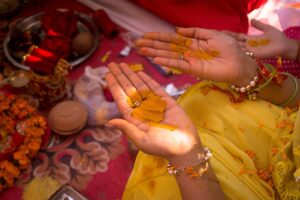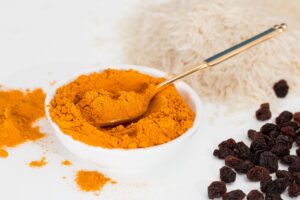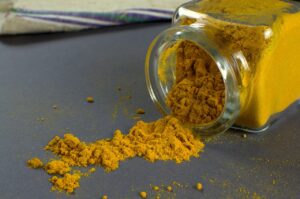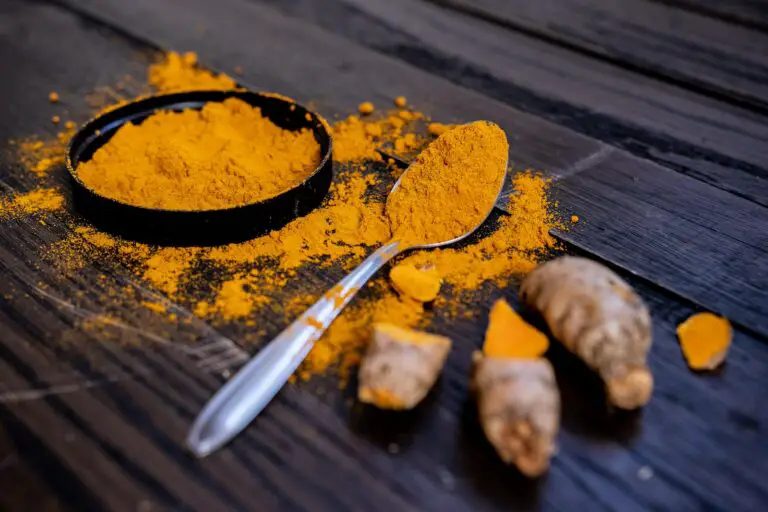Turmeric, a centuries-old spice gracing every Indian kitchen with its presence, boasts more than just its flavorful culinary attributes. This humble spice, with its bright yellow color, commands a prestigious role in Indian customs and culture, particularly in Indian weddings. At the heart of ‘Haldi’, the traditional Indian wedding sequence, turmeric serves as a symbol of purity, fertility, and prosperity. This blog post explores turmeric’s role in wedding traditions and ceremonies, shedding light on its fascinating cultural significance.
Haldi Ceremony in Indian Weddings

Indian weddings, grand and extravagant as they are, encompass a series of rituals leading up to the wedding day. Among such rituals is the revered ‘Haldi’ ceremony, a ritual that involves covering both the bride and groom in a yellow haldi paste. Recognized for its striking yellow color, turmeric transforms wedding preparations into a vibrant, joyous celebration.
Traditionally, the Haldi ritual involves carefully blending turmeric powder with sandalwood powder, rose water, and sometimes yogurt to create a bright yellow paste. The haldi paste is then applied to the bride and the groom in their respective homes by all the near and dear ones, who smear the paste on their bodies. This ritual signifies the purification and brightening of the soul before the couple embarks on their new life.
The key ingredients used in the typical haldi paste are well-known for their medicinal properties. Turmeric, loaded with an antioxidant called curcumin, exhibits anti-inflammatory, antibacterial, and antioxidant properties which are beneficial for the skin. This spice helps to exfoliate dead skin cells, promoting a glow on the couple’s skin, thereby enhancing their natural beauty. Alongside this, the sandalwood powder offers cooling effects while imparting a sparkling glow.
Medicinal Marvels of Haldi Paste
The ingredients that constitute the typical haldi paste are well-known for their medicinal properties. Turmeric, enriched with curcumin, an antioxidant, exhibits anti-inflammatory, antibacterial, and antioxidant qualities that are beneficial for the skin. This spice assists in exfoliating dead skin cells, unveiling a natural glow on the couple’s skin, thus enhancing their innate beauty. Accompanying this, the sandalwood powder provides a cooling effect while imparting a lustrous sheen.
Significance of Haldi Ceremony

The significance of haldi ceremony extends beyond its role as a beauty treatment. In Indian culture, haldi is considered auspicious and holds a special place in wedding rituals. The yellow color is said to ward off evil spirits and is symbolic of knowledge, learning, and happiness. Haldi ceremony not only augments cosmetic beauty treatments but also acts as a powerful natural remedy, aiding in the bride and the groom’s well-being.
This sacred paste, once applied, is believed to bless the couple with a long-lasting bond, happiness, and successful marriage. It is also considered as a shield against the evil eye, fostering protection.
The significance of this sacred red thread in Indian customs is profound. Turmeric’s role in wedding traditions and ceremonies represents the preservation of not only Indian culture but also the sanctity and purity of holy matrimony.
Conducting Haldi Ritual: Caring For Person Holistically
In preparation for the Haldi ceremony, all the women are dressed in yellow attire as turmeric’s bright yellow color signifies purity and fertility. The yellow clothes further symbolize the Sun, a powerful source of energy, blessing the bride and groom with positive energy and vibrancy for their married life. Applying haldi is more than just a beauty ritual, this ceremony encircles family members wishing for the couple’s well-being and prosperity.
Moreover, the Haldi ceremony soothes pre-wedding jitters. Turmeric, being a natural remedy for an upset stomach and minor body aches, helps alleviate the bride and groom’s anxiety, thus, preparing them for their marital journey.
Turmeric’s Role Beyond the Haldi Ceremony

Turmeric does not just play a role during the Haldi ceremony. The presence of turmeric extends to other Hindu rituals as well. For instance, during the wedding mahurat, a thread dipped in turmeric paste is worn by unmarried friends. This is a custom believed to safeguard them from evil spirits.
Also, in a ritual following the Haldi ceremony, the bride and the groom wear yellow outfits as a symbol of a fresh start. Yellow, an auspicious color, is also believed to keep away evil spirits during the wedding ceremony.
Native to Southeast Asia and India, turmeric rules the roost of natural beauty secrets owing to its health benefits and medicinal properties. Over time, its usage has expanded significantly, appealing to individuals seeking healthy skin and individuals venturing into new beginnings.
Haldi Makes the Bride and Groom Glow – Not Just Literally
In Indian wedding rituals, the shared haldi ritual is believed to tighten the bond between the bride and groom even before they tie the knot. Family members and friends actively participate in this lively ritual, singing traditional songs and celebrating the upcoming union.
The family members of both sides apply the haldi paste on the bride’s and groom’s bodies to ward off evil spirits. It is believed that since the bride and the groom are in such a special state where they would soon transition from their single life to wedded life, they are vulnerable to harmful powers. Therefore, to protect them, this ritual is followed religiously.
In many Indian states, a paste of turmeric, gram flour, and oil is made and applied not just to make the skin fairer, but also to symbolize a purification ritual. The paste is applied three times: first by the applicator’s palms, then using mango leaves, and lastly by hands again. All these applications have their own significance and meaning.
Turmeric’s Rich Historical Significance in Indian Culture
Turmeric’s vibrant presence extends far beyond its role in wedding traditions and ceremonies; its historical importance in Indian culture has deeply rooted significance. Native to Southeast Asia and India, turmeric has been used for thousands of years not only as a culinary spice but also as a medicinal herb and even a dye. Its distinct yellow hue has made it a symbol of auspiciousness, purity, and vitality in various aspects of life.
Turmeric: A Journey of Tradition and Holistic Wellness

The use of turmeric in Indian weddings goes beyond just rituals and symbolism—it’s also deeply connected to holistic wellness. The application of haldi paste during the Haldi ceremony is not merely for cosmetic enhancement, but for its therapeutic properties as well. Turmeric, rich in curcumin, boasts anti-inflammatory and antibacterial qualities, aiding in maintaining healthy skin. The blend of sandalwood powder and rose water in the haldi paste contributes to a refreshing and soothing experience for the bride and groom, promoting both physical and mental well-being.
From Spice Rack to Sacred Symbolism: Turmeric’s Transformation
Turmeric’s transformation from a common kitchen spice to a sacred symbol of love and purity in wedding ceremonies is a testament to India’s diverse cultural tapestry. The evolution of its role reflects the amalgamation of traditional beliefs and the embrace of natural remedies. While turmeric’s rich color continues to ward off negative energies and its application fosters a sense of protection, its journey into the realm of weddings showcases how cultural elements can evolve over time, creating a rich tapestry of meanings.
Turmeric and its Multifaceted Symbolism
Beyond its direct application on the bride and groom, turmeric has a multifaceted presence in various pre-wedding rituals. The tradition of wearing a thread dipped in turmeric paste during the wedding mahurat by unmarried friends serves as a powerful symbol of safeguarding against malevolent forces. This underlines the deep-rooted belief in turmeric’s protective qualities and its role in guiding individuals through important life transitions.
Turmeric’s Resurgence in Modern Weddings
While deeply rooted in tradition, turmeric’s significance is not confined to the past. Modern Indian weddings continue to embrace turmeric’s role, often incorporating it into contemporary wedding themes and décor. From incorporating turmeric motifs in wedding invitations to using its distinct color as part of the overall wedding palette, this ancient spice maintains its relevance in the ever-evolving landscape of Indian weddings.
The Cultural Echo: Turmeric in Global Awareness
In recent years, turmeric’s remarkable health benefits and cultural significance have gained global attention. Its emergence as a superfood has sparked interest far beyond India’s borders. People around the world are discovering and incorporating turmeric into their lifestyles for its potential health advantages. As this awareness spreads, so does the understanding of the rich cultural tapestry that turmeric is woven into.
Turmeric’s Timeless Role: Uniting Tradition and Modernity
The enduring presence of turmeric in Indian wedding traditions is a testament to its timeless role in uniting tradition with modernity. Amidst the dynamic changes that societies undergo, turmeric’s symbolism remains steadfast, providing a link to ancestral wisdom and cultural heritage. Its incorporation into contemporary weddings showcases the adaptability of cultural elements while preserving the essence of time-honored beliefs.
Turmeric’s Role in Wedding Traditions and Ceremonies
Turmeric holds such a special place in Indian weddings and traditions due to its symbolic representation and the various health benefits it offers. Be it alleviating pre-wedding jitters, rendering a blemish-free skin, or warding off the evil eye, Turmeric has proved itself to be a super spice that enriches wedding traditions and ceremonies. As we approach the wedding season, remember the role of turmeric as you cheer a couple on their wedding day, and join in the celebrations that echo Indian culture.
With thousands of years in use, the haldi ceremony is a tangible testament to an eternal tradition. The yellow of turmeric, ever constant, ever bright, continues to guide couples into their happy married life.
Turmeric – The Auspicious Color Yellow
The auspicious color yellow is associated with learning, knowledge, and happiness – all of which are essential for a successful marriage. During the haldi function, the bride, groom, and all the women present are dressed in yellow attire.
The significance of turmeric’s bright yellow color is also tied to its ability to ward off evil spirits or buri nazar (evil eye). It’s believed that wearing and applying turmeric paste keeps the negative energies at bay. In the same vein, the bride and groom wear yellow clothes after the haldi ritual to signify protection against negative energy and herald a new beginning. Turmeric also represents the sunlight, a symbol of optimism and warmth which is further believed to usher in prosperity and blessings for a bright married life.

